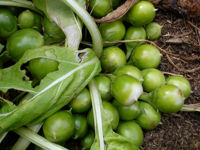Mandrake
 From Conservapedia
From Conservapedia | Mandrake | |
|---|---|

| |
| Large bunch of mandrakes in a field | |
| Scientific classification | |
| Kingdom Information | |
| Kingdom | Plantae |
| Phylum Information | |
| Phylum | Magnoliophyta |
| Class Information | |
| Class | Magnoliopsida |
| Order Information | |
| Order | Solanales |
| Family Information | |
| Family | Solanaceae |
| Genus Information | |
| Genus | Mandragora |
| Species Information | |
| Species | M. officinarum |
| Binomial name | Mandragora officinarum |
| Population statistics | |
The true mandrake, also known as the European mandrake or love apple or Satan's apple, is a flowering plant (genus Mandragora) of the family Solanaceae. It enjoys a dubious renown for magical properties and is definitely known as a source of potent alkaloids that can have a medicinal value or be abused as hallucinogens.
Contents
Anatomy[edit]
The mandrake is characterized by its large, brown root, growing 3 to 4 feet deep into the ground. It is sometimes single but usually bifid,[1] and in fact the bifid root strongly resembles the human form.[2][3]
The dark-green leaves spring from the crown of the root. At first they stand straight up, but eventually they grow 12 inches long and 4 to 5 inches wide and lie on the ground. The flowers arise from among the leaves. Each flower has its own stalk that stands 3 or 4 inches high. The flowers resemble primrose flowers, with five whitish-purple segments.
Eventually the flowers form smooth round fruit, deep yellow, about the size of a small apple and smelling like an apple when cut.[1][4]
Ecology[edit]
The mandrake is native to southern Europe and the Mediterranean region, including Lebanon, Syria, and Israel.[1][4] It is cultivable in a garden but will not survive a harsh winter.[1]
Chemistry[edit]
The mandrake produces at least four powerful alkaloids, including atropine, scopolamine, hyoscyamine, and mandragoramine.[5] Atropine is a commonly used antidote for accidental poisoning by nerve agents. Scopolamine gained a reputation, during the Second World War, as a "truth agent." All of these alkaloids are narcotics and have narrow therapeutic windows and low lethal dose:therapeutic dose ratios. For these reasons, the mandrake must be considered toxic and should be handled with care.
Uses[edit]
Mandrakes are not commonly used today, though at least one of its alkaloids (atropine) is. In ancient and medieval times, the mandrake found use as an aphrodisiac[6] (and in fact is the oldest reputed aphrodisiac known to Western civilization[7]) an anesthetic,[2][4] and a narcotic.[2][6] One major use, now obsolete, is in the treatment of obstructive pulmonary disease, including asthma. The mandrake also found use in the treatment of common gastrointestinal conditions, including peptic ulcer disease and colic.[5]
Reputation[edit]
Biblical[edit]
The oldest mention of the mandrake is in the Bible. Specifically, Reuben, son of Jacob and Leah, reportedly gathered mandrakes from a wheat field during the time of wheat harvest (late springtime) and brought them to his mother. Leah then used them to bargain with Rachel for the affections of Jacob, their common husband.[8]
Reuben did this because he knew the reputation that mandrakes had as a charm against infertility. That Reuben could have gathered the mandrakes without poisoning himself is remarkable, but perhaps he had sufficient presence of mind not to handle them directly but to gather them in the folds of his robe.
Extrabiblical[edit]
Perhaps because of the toxic effects of the mandragora alkaloids (especially mandragoramine) and also because of its human-seeming form, the mandrake gained a reputation for inciting insanity in anyone who pulled it out of the ground. As the story went, the mandrake would scream when uprooted, and the screams themselves would drive all who heard them into mania.[3][6] Of course, plants do not scream—but perhaps those who tried to harvest mandrakes with their bare hands did, especially if their hands were cut or abraded and they suffered acute mandragoramine poisoning.
Some who wished to harvest mandrakes would first loosen the earth around them and then would leash a dog to a mandrake and then call the dog from a distance. Legends state that many dogs died that way, but perhaps the dogs died from chewing on the mandrake roots in efforts to free themselves, thus ingesting lethal doses of the alkaloids.
As mentioned, the mandrake was supposed to carry a fertility charm. It was also supposed to have occult powers. Warriors used it to confer invulnerability, and explorers used it to help discover hidden treasure.[3]
Gallery[edit]
References[edit]
- ↑ 1.0 1.1 1.2 1.3 Grieve, M. "Entry for 'Mandrake'." A Modern Herbal. Accessed January 2, 2008
- ↑ 2.0 2.1 2.2 Authors unknown. "The Mandragora Plant—Myths and Other Information." Anesthesia Historical Background. Accessed January 2, 2008.
- ↑ 3.0 3.1 3.2 "Mandrake." Encyclopedia Mythica. 2008. Encyclopedia Mythica Online. Accessed January 2, 2008.
- ↑ 4.0 4.1 4.2 Authors unknown. "Entry for 'Mandrake'." Monstrous.com. Accessed January 2, 2008.
- ↑ 5.0 5.1 Authors unknown. "Entry for 'Mandrake'." DrugDigest.com. Accessed January 2, 2008.
- ↑ 6.0 6.1 6.2 "Mandrake." The Columbia Encyclopedia, 6th ed. New York: Columbia University Press, 2001–07. Accessed January 2, 2008.
- ↑ "Oldest aphrodisiac." World Sex Records. Accessed January 2, 2008.
- ↑ Genesis 30:14-17
Categories: [Vegetables]
↧ Download as ZWI file | Last modified: 03/27/2023 05:00:01 | 42 views
☰ Source: https://www.conservapedia.com/Mandrake | License: CC BY-SA 3.0
 ZWI signed:
ZWI signed:
 KSF
KSF